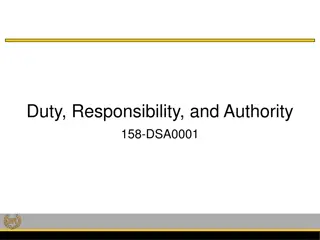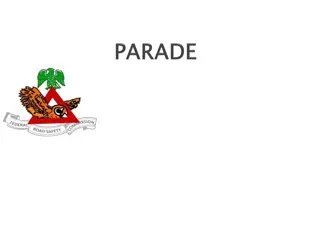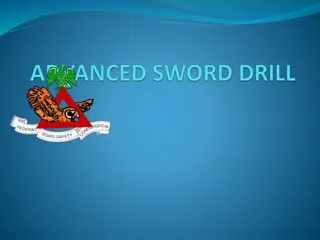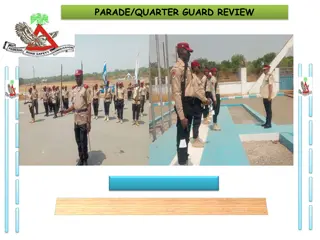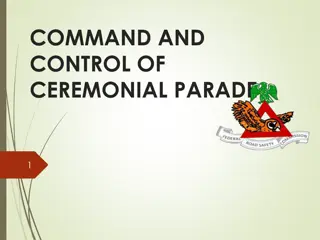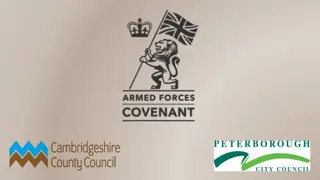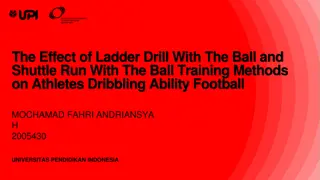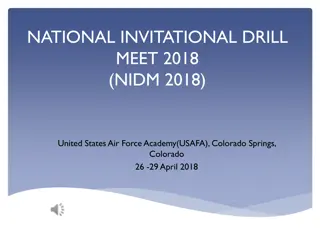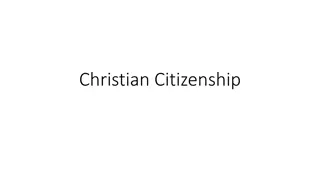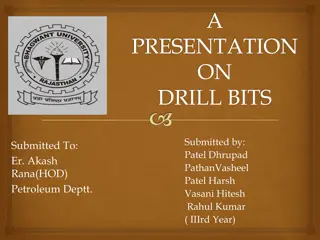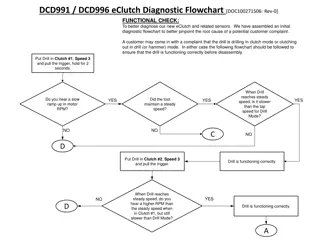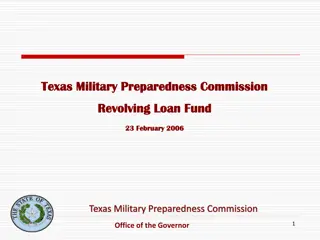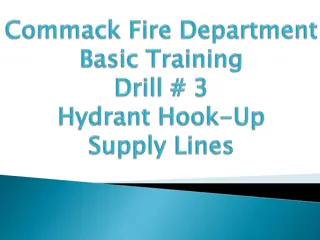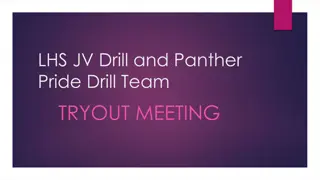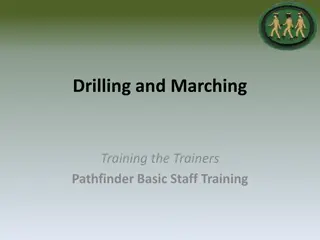Understanding the Significance of Military Parades and Drill
Military parades and drill play crucial roles in showcasing military strength, instilling discipline, and ensuring cohesion among soldiers. While parades can be ceremonial or routine, drill focuses on training soldiers to act instinctively in various situations. Learn about the essence of Vesting Day Parade and key qualities of a parade commander in this informative lecture.
Download Presentation

Please find below an Image/Link to download the presentation.
The content on the website is provided AS IS for your information and personal use only. It may not be sold, licensed, or shared on other websites without obtaining consent from the author. Download presentation by click this link. If you encounter any issues during the download, it is possible that the publisher has removed the file from their server.
E N D
Presentation Transcript
A military parade is a formation of soldiers whose movement is restricted by close-order maneuvering known as drilling or marching. The military parade is now almost entirely ceremonial, though soldiers from time immemorial up until the late 19th century fought in formation. Massed parades may also hold a role for propaganda purposes, being used to exhibit the apparent military strength of one's nation. 2
Military drill is memorizing certain actions through repetition until the action is instinctive to the soldiers being drilled. Complex actions are broken down into simpler ones which can be practiced in isolation so when the whole is put together the desired results are achieved. Such is necessary for a fighting force to perform at maximum efficiency in all manner of situations 3
However, depending on the army and the drills it adopts, drilling may destroy flexibility and initiative in exchange for predictability and cohesion. Recruits in most modern militaries are taught drill to teach them how to work and move as a team. 4
Parades may either be routine or ceremonial depending on the purpose. Vesting Day parade is a form of ceremonial parade still in practice today in all military and formations. It serves the sole purpose of vesting authority Commander in the formation or Command as the case may be. Para- military on the in-coming
This lecture seeks to acquaint participants with the rudiments of Vesting Day Parade 6
At the end of this presentation, participants should be able to: a. Briefly discuss Vesting Day Parade b. Outline the sequence of Vesting Day Parade c. Mention at least five qualities of a parade commander 7
Handing and taking over parade otherwise known as vesting day parade is conducted to mark the end of the tenure of a Commanding officer in a Command and the commencement of new tenure of Office of the Incoming Commanding Officer to that Command. 8
The importance of this parade is underscored by the following: a. It provides the forum for the outgoing Commander to bid farewell to officers and marshals of the command. a. It gives the in-coming officer the opportunity to impress his personality and style of leadership on the officers and Marshals during his introductory address. a. It enhances a quick rapport between the in-coming Commanding Officer, and officers and Marshals of the Command. a. It enables all staff to understand the style of leadership of the new Commanding Officer and what he intends to achieve during his tenure of office. 9
A parade of not less than two (2) guards forms up at the parade ground. In this parade, guards are formed due to availability of Staff (Officers and Marshals) in the Command. The composition of each guard is 48 Marshals and 3 Officers (one Guard commander and 2 sub-Guard commanders). The parade usually has guards in even numbers of 2, 4, 6 or 8. RSM hands over the parade to the parade 2i/c who commands the Officers to fall in. The guard and sub-guard commanders take their positions in front of the guards and observe their dressing. 10
The 2i/c hands over the parade to the parade commander and 2i/c marches off and takes his position in guard one. The parade commander calls the colour party to march in the Colours, the colour party marches in, take their position and observe their dressing in line with the body of the parade. 11
After this the parade awaits the arrival of the senior Officers of the command who take turn to take salute if need be. The in-coming Commanding Officer and out-going Commanding Officer who will serve as the special Guest of Honour, may or may not inspect the Quarter Guard before arriving at the parade ground. The out-going Officer will mount the saluting dais while general salute will be -rendered. 12
The Out-Goining Commanding Officer will inspect the parade and where it can be accommodated, the parade will march past in slow and quick time. Thereafter, they will advance in review order and the out-going Commanding Officer will give his farewell address and thereafter he will retire to take his seat at the VIP stand. 13
The in-coming Commanding Officer will give his own address mainly on his style of leadership and what he intends to achieve in the command. Immediately after his address, he will retire to the VIP stand. 14
The tableparty will march in with the table to the front of saluting dais. The out-going and in-coming commanding Officers will sit on the chairs provided at the table and sign the handing and taking over note while the principal Officers of the command witness. Thereafter, the table party marches in and remove the table from the parade ground. 15
The flag/colour of the command will be marched to the parade ground, ( where the command does not have its own separate colour; the FRSC flag may be used). The Officer carrying the flag will present it to the out- going Commanding Officer who will in turn present it to the in-coming commanding Officer. The handing over of the unit flag presupposes the symbolic change of guard or commandship from the former to the later. 16
The returns to the saluting dais to receive THREE HEARTY CHEERS . After this, general salute will be rendered and then the parade commander will march towards him and take permission to carry on with the parade. Then the parade marches out in column of routes. out-going commanding Officer 17
A parade commander should possess the following characteristics: a. A parade commander must have a good understanding of parade. b. A parade Commander should be highly regimented. c. Skilled in commanding parade and inspiring presence. d. Possess an exceptional marching technique. 18
e. His vocal are loud and easily understood. f. Highly responsible and reliable. g. A team player. h. A highly focused Officer. i. A teacher and a teachable spirit. 19
It is quite imperative for all officers to learn these parades to refresh their minds with the sequence of mounting and inspection of parades especially Handing and Taking over . This is vital as they are the custodians of the cultures and traditions of the institution so as to pass it on to younger generations. All should be knowledgeable in its sequence as any officer can find himself reviewing a passing out parade in another Uniform organization. 20
Ceremonial for the Army NAVMC 2691 Marine Corps Drill and Ceremonies Manual, Headquarters, United States Marine Corps, 1981 Oludare Ogunjobi- Parades and Regimentation in FRSC 21

 undefined
undefined


